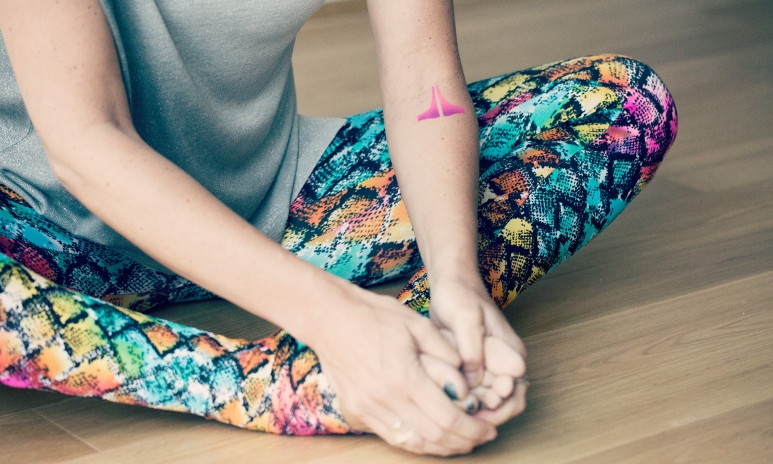A cheat sheet for beginners to get started on their yoga journey

Photo courtesy of Flex Studio
If you’re new to the world of yoga, then you’ve probably experienced the overwhelming sense of self-consciousness that hits as you enter a studio full of seasoned practitioners.
To help guide you through the confusion of downward dogs and backward bends, we enlisted the expert advice of Joy Wang, Programme Manager of Yoga in Odinson, Heloise Cheong, Yoga Instructor at Flex Studio and Kelsea Bangora, an award-winning international yoga instructor. Time to roll out your yoga mat, here’s everything you should know before your next class.
Gear up properly

Photo courtesy of Odinson
It’s best to wear comfortable, form-fitting clothes, such as a tank top and leggings that are specifically designed for yoga, says Bangora. “Avoid polyester clothing that is too big or too tight, such as over-sized T-shirts which tend to flap around when you’re in positions such as ‘downward facing dog’,” points out Wang. Yogis should opt for apparel that allows you to stretch properly and doesn’t restrict your movement.
“The materials of your yoga outfit should also depend on the classes you sign up to,” says Cheong. “For example, quick dry clothing is preferred in hot yoga or Bikram classes.”
The key to focus

Photo courtesy of Odinson
We’ve all been there – failing to concentrate as we‘re letting out the “oms” at the yoga studio after a long day of work. “To improve your focus when practising yoga, be present in your mind,” points out Cheong. To enter ‘the zone’, or what yogis refer as ‘mindfulness’, try to completely let go of other things during the yoga sections, that includes your To-Do lists, and your worries of today and tomorrow, says Wang.
Best times to do yoga

Photo courtesy of Michelle Proctor Photography
Finding time to do yoga is a luxury when you live in a fast-paced city like Hong Kong. “When you have full control of your schedule and have developed the discipline, morning practice is what most experienced practitioners recommend,” underlines Wang. Wake up your body with a couple of back bends in your morning yoga classes, and try forward bends during evening practices to unwind after a long day, says Bangora.
It’s all about breathing

Photo courtesy of Flex Studio
Breathing plays a crucial role in the world of yoga. “Asana practice is about learning how to breathe deeply and through deep breathing, we relax our muscles and flexibility comes,” says Wang. If your breath is becoming short, rapid, or constricted, back out of the pose and try a modification or different posture that best serves your body.
Avoid common mistakes

Photo courtesy of Michelle Proctor Photography
“Allocate adequate time before and after class so you have enough time to wind down and move onto the next activity. Avoid rushing into a classroom to try to relax and don’t rush off once it’s over,” says Wang. Yogis should also avoid over-eating before yoga and try to eat at least around one to two hours before class. Many yoga poses are in a prone position and therefore overeating may cause an upset stomach, she notes.
Don’t push yourself too hard

Photo courtesy of Odinson
While you’re always encouraged to try new poses and hold certain postures for a longer time, it’s crucial to know your limits. “Listen to your body – it will tell you whether it’s a muscular pain or sharp pain,” points out Cheong. “Resist the urge to rush into a pose. Always allow your breath to guide you and enable you to progress at your own pace.” As a rule of thumb, yoga is supposed to help individuals to strengthen or heal themselves, instead of causing strain or injuries to your bodies.
Do your homework

Photo courtesy of Michelle Proctor Photography
For Cheong, she finds it helpful to take notes after every class. Consider keeping a practice journal and jot down anything from your “aha!” experience and breakthroughs, to drawings of postures or new terms you would like to remember.
Practice makes perfect

Photo courtesy of Flex Studio
“It’s through frequent practice, direct experience and explorations that we discover what works well and what doesn’t,” points out Wang. Beginners should try going to classes every day during the first week in order to immerse themselves in the practice to notice the benefits outside the studio, notes Bangora. Afterwards, try committing to attending classes at least twice a week to start seeing improvements in your practice.
Try different teachers

Photo courtesy of Odinson
“Take multiple classes until you find a teacher who you click with. Once you’ve found a teacher that you like, stalk their schedule and take all of their classes,” underlines Bangora. “You are far more likely to go to class if you like the instructor. Teachers tend to become attuned to their regular students’ practice and therefore, are more able to help you improve your yoga practice. It’s beneficial to have a watchful pair of eyes on you during the class, she notes.
Start off with simple classes

Photo courtesy of Odinson
Always take note of your physical condition and any chronic injuries before signing up for a class, underlines Cheong. “If you’re feeling energised, and would like to use yoga as part of a cross-training programme, go for a Vinyasa or Hatha class. If your level of fitness is quite low, take a beginner-friendly Bikram style class, as it’s a set sequence so you can learn all of the poses and see your progress over time, all while getting a good sweat on,” points out Bangora.
